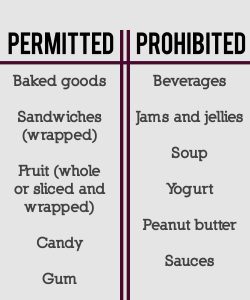Posted October 14, 2016
By JULIE HARANS
Between long lines, lost luggage and seemingly endless wait times at the gate, air travel can be a stressful experience. And nothing fuels aggravation like an empty stomach – another problem that’s difficult to solve in an airport terminal.

A concourse at Miami International Airport (Photo courtesy Miami-Dade Aviation Department).
For the most part, options are overpriced and unhealthy, and packing your own meal brings a whole other batch of complications.
Airports’ food restrictions are so misunderstood, in fact, that some travelers aren’t even aware that they’re permitted to bring food items on board at all. Depending on personal preference, there are a variety of ways to overcome the challenge of airport eating.
CARRYING ON
Bringing food from home saves money and time that could otherwise be spent waiting for a table at a terminal restaurant, but the security rules can be tricky. One of the reasons airport food regulations are so confusing is that they aren’t logical enough for the average passenger to safely assume whether an item is permitted or not. For example, on the Transportation Security Administration (TSA) site, “firm cheese” is listed as acceptable to bring on board, but “firm” is a subjective term that is defined by the TSA officer’s discretion.
This list of permitted food items has been updated several times in the past decade. Not only is it subject to change without warning, but the specific requirements for bringing those foods on board also vary. According to Consumerist.com, sandwiches, sliced fruit and even burgers can pass through TSA; however, they must be wrapped or placed in a container. Be aware that the rule prohibiting more than 3.4 ounces of liquid in carry-on baggage still applies, and items including pudding, hummus and applesauce are considered liquids.

Some food items including cakes and pies may be subject to additional screening. As TSA’s website states, “the final decision rests with TSA on whether to allow any items on the plane.” Since the rules of bringing food on board tend to get a little fuzzy, here’s a breakdown of the basics:
For more detailed inquiries, TSA developed an app that allows passengers to search for specific food items and find out if they’re permitted on board.
Hungry travelers should also check out “The Portable Feast,” a book by food Blogger Jeanne Kelley, who has mastered the art of packing on-the-go meals.
IN-FLIGHT EATS
By June 2011, all major airlines began charging for meals during domestic flights, according to The New York Times. This shift inevitably limits the options for in-flight eating, but there are still some resourceful alternatives. Preparing a meal and freezing it beforehand is one method – simply freeze the food at least 24 hours in advance and make sure it’s adequately sealed. By takeoff, dinner is served.
Or snag an age-old trick from college dorms: Ask a flight attendant for a cup of hot water and use it to cook rice and pasta dishes right at your seat.
University of Miami senior Anastasia Novak said she always packs food to bring on flights – and she’s no stranger to air travel. Born in Belgium, Novak has traveled across the globe throughout her life. She now flies internationally about one to two times a year, and domestically about two to three times a year, mostly out of the Fort Lauderdale and Miami International Airports. For Novak, packing sandwiches, fruit and snack bars is essential.
“This is a great move if you’re going to be away from home for a while and need to clean out the fridge anyway,” she said. “It will save you money, and when you make it yourself, you know you’re going to be satisfied when you’re catching the redeye versus embarking on a quest for an open restaurant in the middle of the night in a foreign country.”
Novak said she feels she has a pretty strong understanding of the TSA guidelines when it comes to bringing food on board, though she recognizes that the United States is much more restrictive than other countries.
But when it comes to bringing meals on board the aircraft, be mindful of other passengers. The basic rules of etiquette still apply 30,000 feet up, so try to keep mess – and smell – to a minimum. When a single passenger stinks up the plane, the source is obvious, and you’ll likely be glared at for the remainder of the flight.
TERMINAL DINING
For passengers who choose terminal dining, the experience can be just as frustrating. Airports create captive audiences, meaning that travelers’ options are limited to the ones presented in that isolated area. This lowers consumers’ expectations and in turn lowers the standard of options and raises prices.
Food service providers tend to be less influenced by the captive audience concept, however, if they began as privately-owned restaurants rather than airport businesses. One such service provider is Global Miami Joint Venture, the master concessionaire that oversees all the dining options at Miami International Airport (MIA).
This includes 23 restaurants, from local Cuban cafes such as Versailles and La Carreta to national chains such as Burger King and Starbucks. In addition, MIA dining options range from quick-service spots to seated restaurants with full bars. Vice President Dale Robinson said providing a multitude of choices is MIA’s response to the common inconveniences of airport dining.
“The way we’ve addressed it is by doing multiple concepts in different service styles,” Robinson said. “We go from one end of the spectrum to the other, which allows us to answer the needs of a multitude of passengers as opposed to one segment.”
Miami-Dade Aviation Director Emilio T. González echoed this emphasis on variety.
“We understand that our customers have diverse taste,” González said in a press release. “Our growing list of shopping and dining locations provides our passengers even more variety to choose from.”
However, Novak suggested sticking with familiar and simple fare, especially when traveling overseas.
“Your body goes under stress when traveling, so it won’t be the most welcome to random foods you find out of desperateness,” Novak said.
She also encouraged hydration and a balanced diet, two factors that are increasingly recognized as important during travel. The National Restaurant Association reported nutrition as one of the top 10 culinary themes in 2016, and fortunately, that emphasis on health has begun extending to airport dining.
According to The Physicians Committee’s 2015 Airport Food Review, the farm-to-table movement is growing in popularity, leading to fresher options that utilize more produce. The San Francisco International Airport, Logan International Airport and John F. Kennedy International Airport are just a few of the establishments incorporating locally grown ingredients into their menus.
The 2015 Airport Food Review also reported the popularity of “build-your-own” options, which give travelers more control over what they eat, enabling them to make healthier choices. The Physicians Committee even suggests that eating colorful, antioxidant-rich meals can help alleviate some stresses of travel, since “plant-based dietary patterns boost both mood and the immune system.”
While dining can be another inconvenience in the headache of air travel, healthy and practical options do exist; all it takes is some knowledge and preparation. But if that’s too much effort to expend for a single meal, skip the stress and eat beforehand at home, where there’s no X-ray screening between you and your meal.
